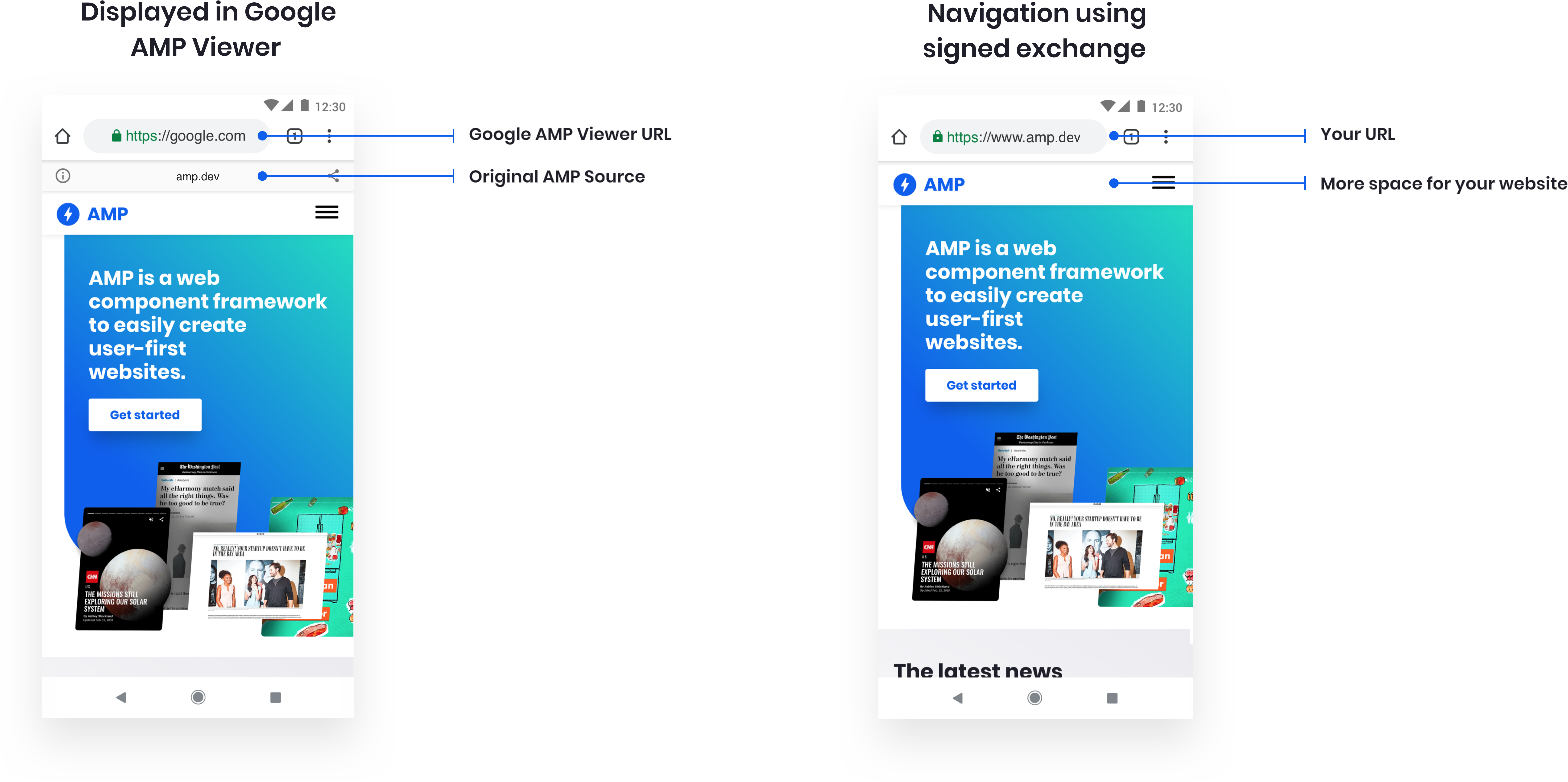ทำความเข้าใจการทำงานของ AMP ในผลการค้นหา
Google Search จะจัดทำดัชนีหน้า AMP เพื่อมอบประสบการณ์การใช้งานบนเว็บที่รวดเร็วและน่าเชื่อถือ เมื่อมีหน้า AMP พร้อมใช้งาน หน้านั้นๆ อาจมีสิทธิ์แสดงในการค้นหาบนอุปกรณ์เคลื่อนที่โดยเป็นส่วนหนึ่งของผลการค้นหาที่เป็นริชมีเดียและภาพสไลด์ แม้ว่า AMP เองจะไม่ใช่ปัจจัยในการจัดอันดับ แต่ความเร็วเป็นปัจจัยในการจัดอันดับสำหรับ Google Search ทาง Google Search ใช้มาตรฐานเดียวกันกับหน้าเว็บทุกหน้า โดยไม่คำนึงถึงเทคโนโลยีที่ใช้ในการสร้างหน้าเว็บ ดูข้อมูลเพิ่มเติมเกี่ยวกับประโยชน์ของการใช้ AMP ได้ในเรื่องราวความสำเร็จของโครงการ AMP
เมื่อผู้ใช้เลือกหน้า AMP ทาง Google Search จะดึงข้อมูลหน้าจากเซิร์ฟเวอร์แคช AMP ของ Google ซึ่งจะเปิดใช้การเพิ่มประสิทธิภาพในการโหลดหลายอย่างที่ทำให้หน้าโหลดได้ทันที เช่น การแสดงผลล่วงหน้า ในขณะนี้ หน้า AMP ในเดสก์ท็อปจะไม่แสดงจากเซิร์ฟเวอร์แคช AMP ของ Google/โปรแกรมเปิด AMP และหน้า AMP ที่เป็น Canonical จะแสดงเป็นผลการค้นหามาตรฐาน
การแสดงผลเริ่มต้นในผลการค้นหา
หน้า AMP สามารถปรากฏเป็นผลการค้นหาที่เป็นริชมีเดียใน Google Search เช่นเดียวกับหน้าอื่นๆ ในเว็บ คุณเพิ่ม Structured Data ไว้ในหน้าเว็บได้เพื่อช่วยให้ Google เข้าใจหน้านั้นๆ ได้ดีขึ้น โปรดทราบว่า Google ไม่รับประกันว่าการเพิ่ม Structured Data จะทำให้หน้าแสดงเป็นผลการค้นหาที่เป็นริชมีเดียในผลการค้นหา ดูข้อมูลเพิ่มเติมได้ในหลักเกณฑ์ทั่วไปเกี่ยวกับ Structured Data
หากคุณมีหน้าเว็บที่มีเนื้อหาเหมือนกันซ้ำกันหลายหน้า ให้ใส่ Structured Data ที่เหมือนกันลงในหน้าที่ซ้ำกันนั้นทั้งหมด ไม่ใช่แค่ในหน้า Canonical ดูข้อมูลเพิ่มเติมเกี่ยวกับตำแหน่งได้ในหลักเกณฑ์ทั่วไปเกี่ยวกับ Structured Data
หน้า AMP จะปรากฏเป็น Web Stories ได้ด้วย ดูข้อมูลเพิ่มเติมเกี่ยวกับวิธีเปิดใช้ Web Stories ใน Google Search
หลังจากที่ผู้ใช้คลิกเนื้อหา AMP
เมื่อผู้ใช้คลิกเนื้อหา AMP ใน Google Search แล้ว เนื้อหา AMP อาจแสดงขึ้นด้วยวิธีใดวิธีหนึ่งใน 2 วิธีนี้
- โปรแกรมเปิด AMP ของ Google: ที่ด้านบนของโปรแกรมเปิด AMP ของ Google จะมีการแสดงโดเมนของเนื้อหาเพื่อให้ผู้ใช้ทราบว่าใครเป็นผู้เผยแพร่เนื้อหานี้
- Signed Exchange: เป็นเทคโนโลยีที่ให้เบราว์เซอร์ดำเนินการกับเอกสารเหมือนกับว่าต้นทางของคุณเป็นเจ้าของเอกสารนั้น

เกี่ยวกับโปรแกรมเปิด AMP ของ Google
โปรแกรมเปิด AMP ของ Google เป็นสภาพแวดล้อมแบบผสมผสานที่คุณสามารถรวบรวมข้อมูลเกี่ยวกับผู้ใช้ในเบราว์เซอร์ที่รองรับโปรแกรมเปิด AMP ของ Google โปรแกรมเปิด AMP ของ Google อาจแสดงผลเมื่อระบบตัดสินว่าจะมอบประสบการณ์การใช้งานที่เป็นประโยชน์แก่ผู้ใช้ได้ โดยเฉพาะอย่างยิ่งในสถานการณ์ที่คาดว่าจะมีการปัดเพื่อดูเนื้อหา การรวบรวมข้อมูลโดย Google จะเป็นไปตามนโยบายความเป็นส่วนตัวของ Google และในฐานะผู้เผยแพร่หน้า AMP ที่มีเนื้อหาปรากฏในโปรแกรมเปิด AMP ของ Google การรวบรวมข้อมูลของคุณจะเป็นไปตามนโยบายความเป็นส่วนตัวของเว็บไซต์คุณ เนื่องจากว่าคุณเป็นผู้เลือกการทำงานและการผสานรวมผู้ให้บริการในหน้า AMP จึงต้องรับผิดชอบต่อภาระหน้าที่ในการปฏิบัติตามข้อกำหนดอันเป็นผลจากตัวเลือกเหล่านั้น
เกี่ยวกับ Signed Exchange
Signed Exchange ให้คุณใช้คุกกี้ของบุคคลที่หนึ่งเพื่อปรับแต่งเนื้อหาและวัดผลการวิเคราะห์ได้ หน้าเว็บของคุณจะปรากฏใต้ URL ของคุณเองแทน URL google.com/amp
Google Search ให้ความสำคัญกับการลิงก์ไปยังเนื้อหาในแบบ Signed Exchange มากกว่าการใช้โปรแกรมเปิด AMP ของ Google ในเบราว์เซอร์ที่รองรับ Signed Exchange หากต้องการแสดงผลการค้นหาในรูปแบบนี้แก่ผู้ใช้ คุณต้องเผยแพร่เนื้อหา AMP ในแบบ Signed Exchange นอกเหนือจากรูปแบบ AMP HTML ตามปกติ
ในปัจจุบัน Signed Exchange พร้อมให้ใช้งานเฉพาะใน Google Search สำหรับผลการค้นหาที่เป็นริชมีเดียและผลการค้นหาพื้นฐานเท่านั้น จะไม่มีให้ใช้งานในภาพสไลด์ ดูข้อมูลเพิ่มเติมเกี่ยวกับการตั้งค่า Signed Exchange สำหรับหน้า AMP ได้ในแสดง AMP โดยใช้ Signed Exchange
